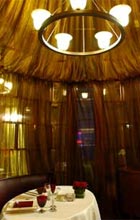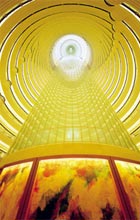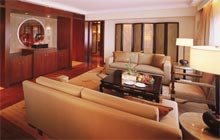
Unhygienic restaurants, surly service and endless stops at "tourist-designated" shops? Fear not, luxury-lovers, for China's top-end travel market is coming of age.
by Guy Rubin, Managing Partner of Imperial Tours

Few luxury tourists landing at Beijing International Airport are prepared for what they will encounter in the Middle Kingdom. The critical tenor of western media typically filters out favorable perspectives of China's development in favor of sensationalist stories, often mistakenly taken as representative. As a result, too often western business and political leaders arriving in Beijing and Shanghai are surprised by the modernity of these urban centres.
To cite a few examples, architecturally the eighty-eight floor Jin Mao Tower serves as comparably contemporary a marker of Shanghai's financial district as the Swiss Re Tower for the City. Across the Huang Pu bay, "Three on the Bund", a lifestyle center accommodated in an Art Deco building, fields western chefs of the caliber of Jean-Georges Vongerichten and management from Claridges. And whereas, inside the Jin Mao Tower, Shanghai can claim to have the tallest five-star hotel in the world, Beijing's Peninsula Palace Hotel is soon to feature a spectacularly luxurious 660 square metre Presidential Suite. As well as representing a superior class of luxury facility, this sample of the best and latest also indicates an ever accelerating trend towards refreshing and improving the stock of restaurants and hotels. The staging of the 2008 Olympics in Beijing adds greater impetus to this growth.
As a tour operating company specializing in the luxury market, Imperial Tours is accustomed to dealing with visitors' culture shock. Some expect poverty, rotten food and dire accommodation, so pack their bags with cans of tuna and health bars "just in case". But these days, luxury visitors encounter world class hotels and gourmet restaurants. If visitors experience a culture shock, it is fuelled by their embarrassment at the gap between their expectations of China and its reality.
None of this would be quite so amazing if people took stock of the amount of money washing around China's inbound tourism industry. In 2002 (the last year for which there are international statistics) China's tourism receipts topped US$20 billion, beating Germany and the UK to fifth position in the destination rankings. Although this leaves it well behind fourth ranked Italy, China's inbound market has been growing at a compound annual rate of 17%. Higher ranked countries' will be looking over their shoulders as China helps itself to an ever increasing slice of the tourist market. Nay-sayers point to the US$3 billion dip in revenue during the SARS scare to highlight the political risk inherent to this destination. Yet they should also take into account the swell in numbers that typically follows such an event, prompted by pent-up demand.
 Let's turn the clock back to 1978 and watch China's first unsteady steps into the international tourist market. At that time, China had practically no facilities bar a few run down guesthouses. Worse still, it had very little money to either invest in new facilities or to train and pay industry personnel, such as the guides, drivers and managers that would populate and operate the new industry. Given this set of circumstances and the centralized thinking of those days, the subsequent solution was pragmatic and intelligent. The National Tourism Administration introduced a range of "tourist-designated" shops and restaurants, which were made compulsory on all tourist routes for all tourist groups. In effect, overseas tour operators had no choice but to supply a product that was defined and enforced in the same way for all customers by a coalition of the central, provincial and local tourism administrations, each of which – to differing extents – had vested interests in these same tourist facilities.
Let's turn the clock back to 1978 and watch China's first unsteady steps into the international tourist market. At that time, China had practically no facilities bar a few run down guesthouses. Worse still, it had very little money to either invest in new facilities or to train and pay industry personnel, such as the guides, drivers and managers that would populate and operate the new industry. Given this set of circumstances and the centralized thinking of those days, the subsequent solution was pragmatic and intelligent. The National Tourism Administration introduced a range of "tourist-designated" shops and restaurants, which were made compulsory on all tourist routes for all tourist groups. In effect, overseas tour operators had no choice but to supply a product that was defined and enforced in the same way for all customers by a coalition of the central, provincial and local tourism administrations, each of which – to differing extents – had vested interests in these same tourist facilities.
This structure facilitated a low overall packaged tour price to China covering plane flight and accommodation expenses. Meanwhile, tourist spending within China was controlled and channeled so as to use commission-generated revenue to pay for guides, drivers, tour escorts and managers. Much of the resulting government income was invested in infrastructure projects in the low income areas in which many tourist destinations are located. In essence this structure remains in place to this day.
For mass market tourism, this formula was a great success: under the direction of the three nationalized tour operators, CITS (China International Travel Service), CTS (China Travel Service) and CYTS (China Youth Travel Service), which between them monopolized the inbound market, the Chinese tourism market grew from a total revenue base of under US$300 million in 1978 to over US$12 billion in 1998, a compound annual growth rate of 19%. Since the rationale of the industry was that one size fits all, there are no figures segmenting this market, but anecdotal evidence suggests that the picture was less rosy in the luxury travel segment.
While mass tourism continued to flourish from the early years, the total number of luxury tourists nose-dived at the end of the 1980's. Disillusioned customers had returned home in the early 1980's with news of characterless restaurants, insipid food, unhygienic accommodation, surly service and a frustratingly endless series of shopping stops interrupting each day's travels. Luxury travelers' perceptions hardened against China as a luxury destination and expectations of luxury facilities dropped to low levels.
The great flaw in the regulatory structure of the Chinese inbound tourist system is in terms of quality. Since sales at restaurants and souvenir-shops have been guaranteed by a combination of regulatory restrictions and the vested interests of tourist industry personnel, there has traditionally been little motivation to preserve or enhance product quality. Furthermore, the inflexibility of the overall structure, guaranteed but also restricted by red tape, means that it has failed to adapt the formulaic budget tour for various market segments. For example, at the end of the 1980's it notably failed to accommodate the greater expectations and comforts of the luxury tourist. In the past, the system was so restrictive that overseas luxury tour operators could only differentiate their high end product by using the better hotels. And as a result, the luxury segment shrank.
The top luxury brands in China today, some of which were mentioned earlier, are all in the private sector. Let us now compare them to the so-called luxury brands that have to date been provided by the state tourist industry. Most luxury tourists to China in the 1980's and to a certain extent today will be familiar with Quanjude Roast Duck Restaurant and Fangshan Imperial Restaurant in Beijing, Defachang Steam Dumpling Restaurant in Xi'an and Louwailou Restaurant in Hangzhou. Though these tourist-designated restaurants admirably serve the purpose of feeding great numbers of people to a moderately good standard, not one of them can compare in food quality or ambiance to the aforementioned luxury brands in the private sector. Indeed, in terms of western sensibilities, it seems somewhat ludicrous to compare them. This is the point – for it demonstrates the inability of the heavily-regulated, top down, command control tourist state sector to cater to a segmented market, in this case the luxury segment. And as a result, overall, the country's tourist market is still losing potential business.
In the hotel sector, the story is similar. Whilst the St. Regis and Peninsula Palace Hotels currently vie for leadership amongst Beijing's plentiful luxury hotels, visiting dignitaries are often rather unsuccessfully accommodated by the local government in the state-owned Beijing Hotel. In an attempt to improve standards, Shanghai's state-owned Jinjiang Group has recently hired a "foreign expert" to upgrade management at Shanghai's historic Peace Hotel. If he succeeds, this will light a path for China's state-owned, luxury hotels to improve their position in China's highly competitive hotel market.
The perception of a sclerotic, and ineffective luxury tourist industry, still prevalent today, was the backdrop to Imperial Tours' inception in 1999. By that time, two important factors had enabled a new breed of overseas tour operator to develop. Firstly, the fragmentation of the CITS / CTS/ CYTS monopoly over ground-handling services in China had served to liberalize the supply side of the market. This introduced an element of competition, reduced the opportunities for graft and has increased the possibility for instituting better quality. Secondly, the increased disposable income of the burgeoning Chinese middle classes, as well as the affluence of the sizeable expatriate markets in Beijing and Shanghai, has encouraged entrepreneurs, both Chinese and western, into the hospitality industry.
Imperial Tours was able to differentiate itself by more than just booking the best hotel. It was able to turn the typical tourist itinerary on its head so that it responded to customer satisfaction rather than the supply-side's revenue structure. Commission-paying shops and restaurants were replaced with gourmet restaurants and visits to crafts studios. These have a higher cost but offer better quality, creating a win-win scenario: China imports more foreign currency whilst visiting luxury tourists receive a superior product. Reducing the time spent shopping, creates more time to visit off the beaten track tourist sites, or to tour well-known tourist sites in greater detail with expert lecturers. Using such innovations, Imperial Tours continues to tailor its product on private and regular departure group tours.
However, it would be misleading to create the impression that the Chinese tourist industry is developing uniformly well across the nation. For example, whilst there is a surfeit of luxury venues and facilities in cities like Beijing and Shanghai, destinations such as Xi'an and Guilin are still found wonting. It is a chicken and egg argument whether restrictive tourist regulations are siphoning off potential customers, or whether the entrepreneurial class is insufficiently funded to take the strain. Either way, until something is done such destinations will continue to deprive themselves of potential luxury tourist income.

Summer 2004, China Review
Reprinted May '05 by the British Chamber of Commerce In China in British Business in China.